Loud noises and flashing lights are alarming for dogs, especially during thunderstorms and fireworks displays. As a result, many dogs experience overwhelming anxiety and fear. While some dogs aren’t affected by these events, others react by cowering, pacing, crying, whimpering and howling. It’s heartbreaking to see your dog suffering and feel as if you’re powerless to do anything about it.
But you can help calm your dog by taking proactive steps. Being prepared and, in some cases, desensitizing your pet can make all of the difference to your dog’s well-being and state of mind. We all want to have happier, healthier and calmer canine companions, so here are some tips to help both you and your dog get through these potentially stressful holidays and weather conditions.
Don’t Take Your Dog to a Fireworks Show

Getty Images
Fireworks are a wonderful experience for humans. They light up the night sky with spectacular colors and intricate designs. Unfortunately for your dog, fireworks can be torture. If your dog never reacted negatively to them before, that doesn’t mean the loud sounds or crowds won’t upset them this time. You may be enjoying the show, and the next thing you know, your dog has made a break for it. By the time you react, they’re already making their way through the crowd away from you.
Dogs can appear calm on the outside but are anxious on the inside, and sometimes, there isn’t any warning when they panic. It’s better for everyone if you leave your dog at home. It will give you peace of mind, not upset your dog and allow both of you to avoid any negative experiences.
Get Out of Town

Getty Images
Generally, there’s some advanced warning with fireworks and thunderstorms. We know fireworks are crucial for July 4 and New Year’s celebrations and know to expect them. Also, when there’s to be a fireworks display for a non-holiday reason, people who live in the immediate area will be notified beforehand. When a big storm is coming, complete with thunderclouds, the weather report will let you know.
If you’re aware of any potential booms, bangs and other loud sounds that may disturb your dog, a great option is to simply get out of town. Go somewhere with milder weather or to someplace out of range of the fireworks.
Double Check That Your Dog Has Been Chipped
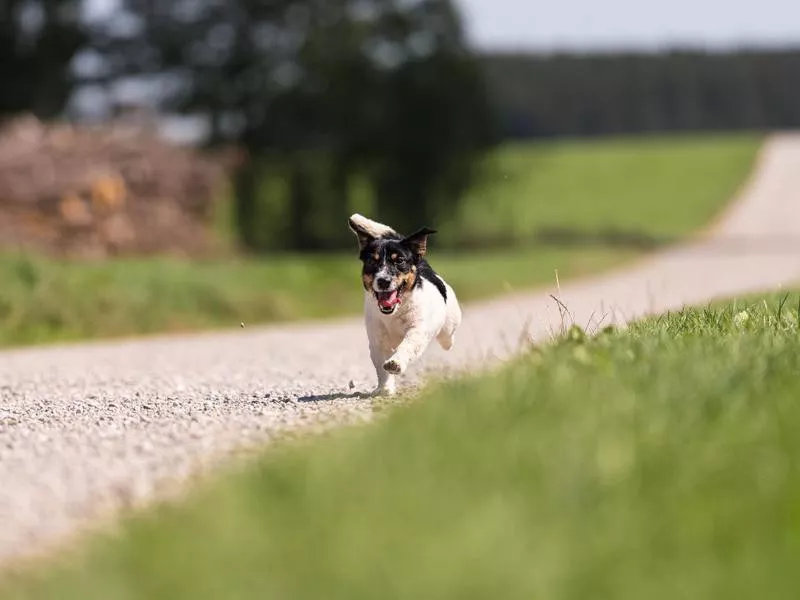
Getty Images
If your dog panics and somehow manages to get out of your house and runs away, you want to be sure to have a way to track them down. Microchipping is a mostly pain-free procedure where your vet will place a microchip under the skin between your dog’s shoulder blades. The procedure will cost approximately $50 and often includes listing your dog in a pet recovery database.
The chip will have important information on it, including a unique number that corresponds to your dog and how to contact you if your dog is found. It’s not a tracking device, and a scanner must be used to get the information the microchip contains, but it can save you a great deal of worry and heartache.
Walk Them Early
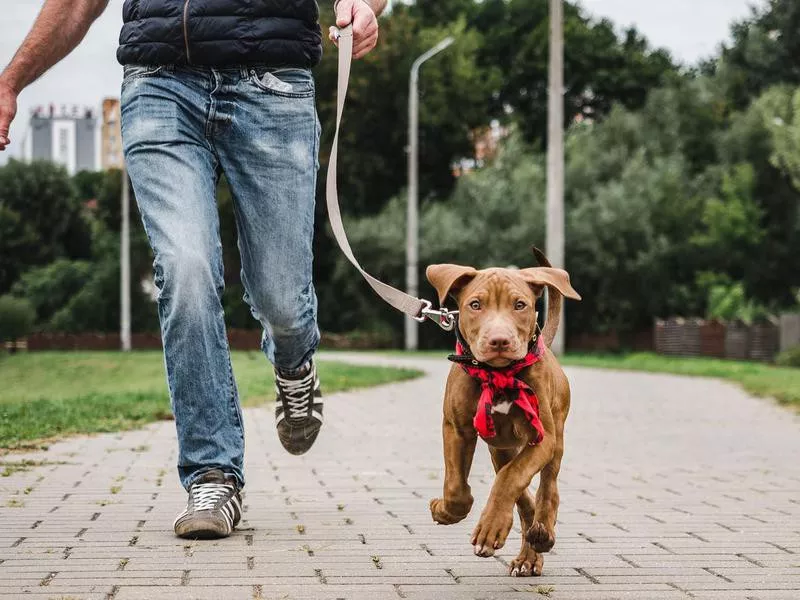
Getty Images
Dogs have a lot of energy — even the older ones, so they must get exercised daily. If you take them on a good walk earlier in the day, it will expel some of their energy and leave them in a more relaxed mood. If you have the time, let the walk turn into an extended playtime.
Take your dog to the dog park, the beach or play with them in your backyard. You want them to get a good workout so that they’ll feel tired but relaxed. Also, being outside for an extended amount of time may cut down on their need to go to the bathroom and help your dog avoid having an accident inside your house.
Don’t Wait to Feed Your Dog

Getty Images
When a dog is scared, the last thing they’re thinking of is eating or drinking water. Dogs need a lot of water to get through the day, and it’s important they don’t get dehydrated during the storm. Like humans, dogs can get sleepy after a meal, so this is a way to help them sleep through the noise.
If they escape, you won’t have any control over their eating or water consumption, and they might have to go a long time without either. If your dog has a regular mealtime for a few days before the fireworks feed them earlier, the routine change won’t seem confusing later.
Escape-Proof Your Home

Getty Images
Don’t assume that your dog won’t flip out from the noise and light shows that go on with fireworks and thunderstorms. If they’ve never reacted in the past, it doesn’t mean they won’t have a negative reaction this time.
All doors and windows of your home should be secured, and potential escape routes like torn screens or doors that won’t stay shut should be repaired and reinforced. Also, make sure anyone coming in or out of your house knows to close the door after them.
Stay Indoors
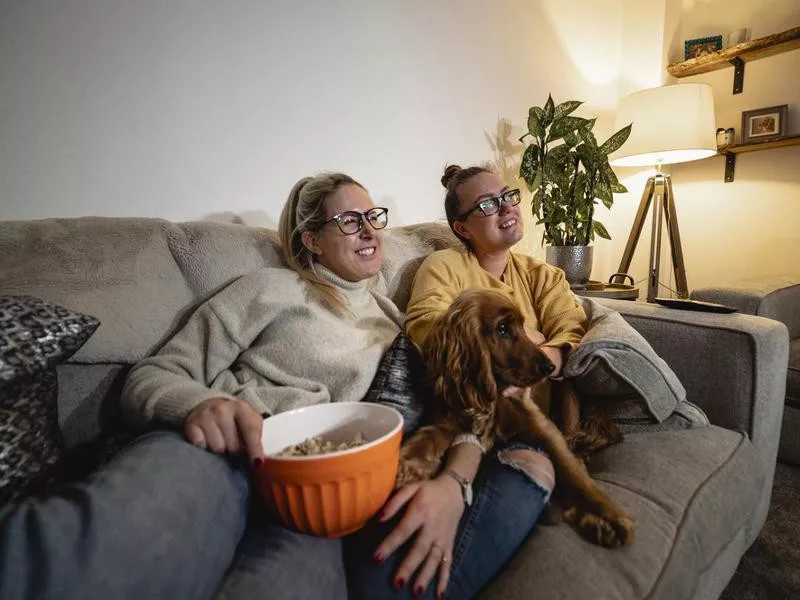
Getty Images
While you may long to get a glimpse of the fireworks overhead, allowing your dog to go outside is risky. Try to limit your dog’s movements to the interior rooms or basement.
You may feel as if you’re in control and that you have a firm grasp on your dog’s leash when you go outdoors, but don’t underestimate the will and the strength of a terrified dog who wants only to get away from the source of its terror. You’ll have more power over how the situation plays out if you and your dog are safely inside.
Provide a Serene Home Environment
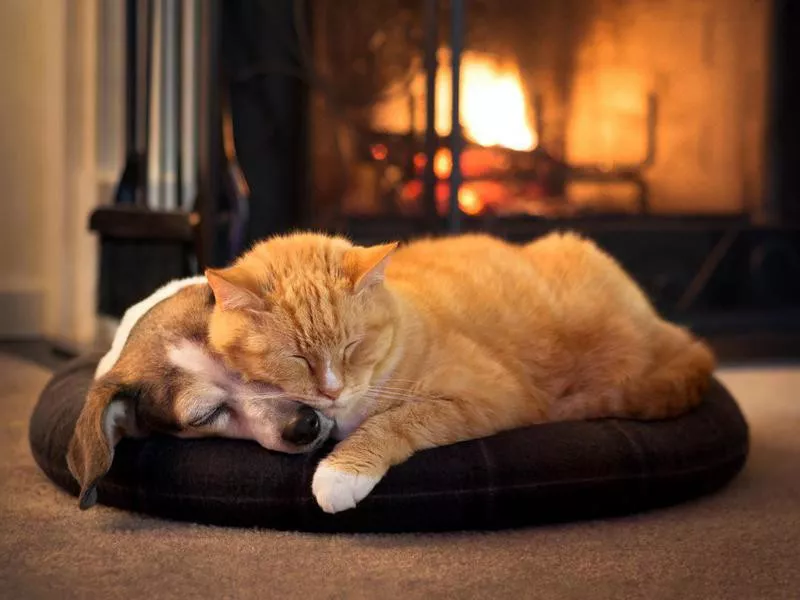
Getty Images
Make sure to close all the curtains and shades to decrease any loud, jarring sounds and block out flashing lights. Don’t keep the inside of the house dark — turn and leave the lights on, which will minimize any flashes of light. Playing soft music, especially classical music, has been known to help keep agitated dogs calm.
Air conditioners, fans or any other type of white noise can help, too. There’s music specially created to calm dogs called “Through a Dog’s Ear” that could help your dog to relax.
Don’t Leave Your Dog Home Alone
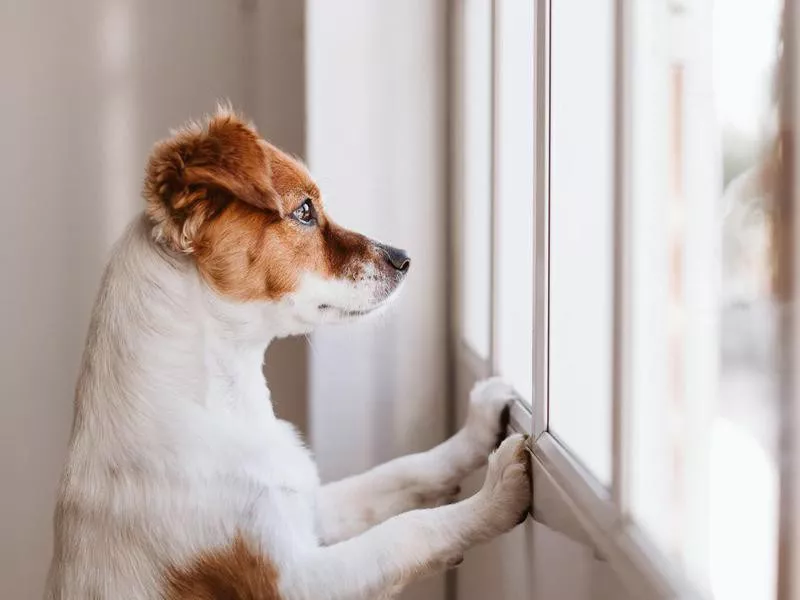
Getty Images
Some pet owners assume that their dogs will be fine on the Fourth of July or New Year’s Eve. You may have a ton of barbecues, block parties and festivities to go to, but leaving a dog who gets stressed by loud noises and flashing lights at home by themself, especially if it is locked up out in the yard, is cruel.
Be the kind of loving companion and best friend your dog is to you, and wait out the fireworks (or storm) with them. It’s your job to make sure your dog is well taken care of and that they feel loved. If you have a partner, you can switch off, so while one enjoys some socializing, the other babysits the dog. After an hour or two, you can swap, so neither of you has to miss the fun.
Create Safe Hideaways
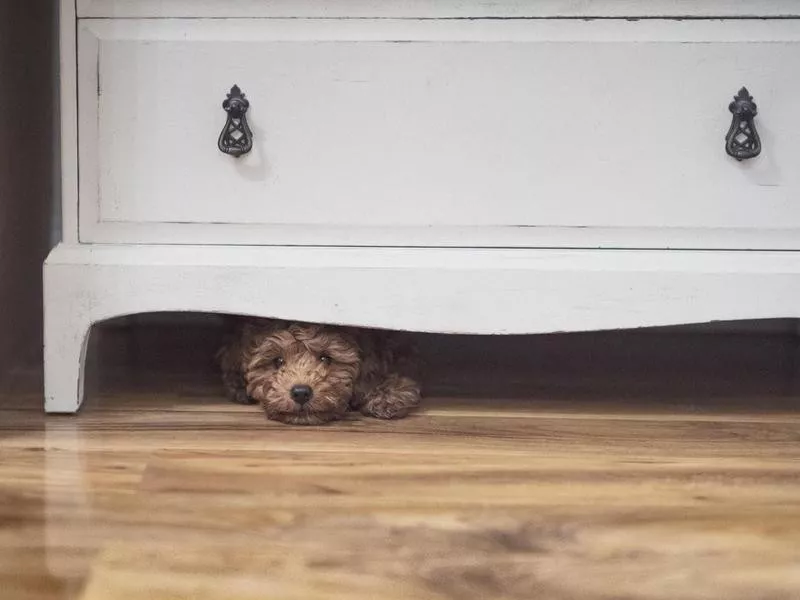
Getty Images
If your dog has already established spots where they like to hide, make sure that they have access and can get in them easily. If they don’t have any favorite hiding places, create some for them. Some things you can do are to drape a table with a blanket and make a fort, cover a crate with fabric, put some blankets inside their crate and leave it open, or prop open a linen closet door and make a comfy space for them at the bottom.
Give them a choice; if one doesn’t work out, the next one might. Don’t lock them in their safe place, for they could panic and hurt themselves trying to get out. You want the space to feel like a sanctuary or retreat, not a prison.
Help Your Dog Equate the Safe Area With Positive Experiences
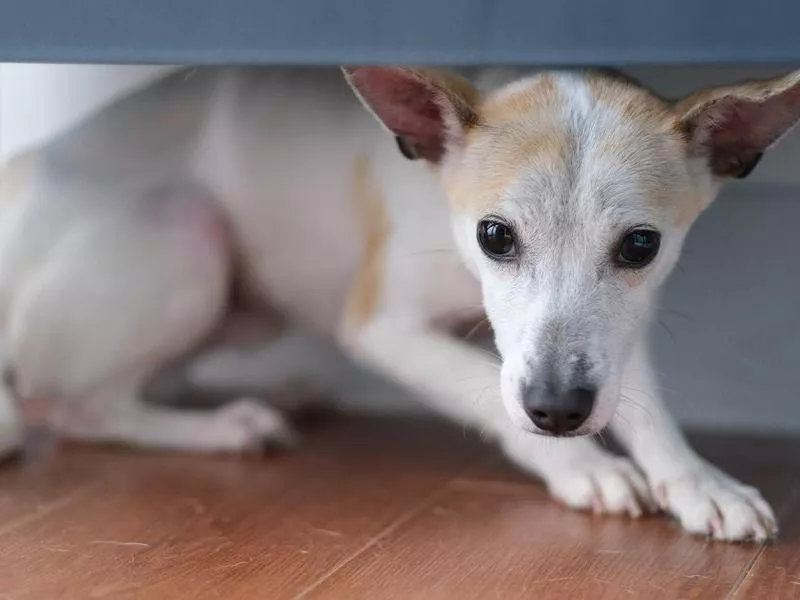
Getty Images
Try to set up the safe places a few days ahead of the fireworks or storm and spend some time snuggling and loving them there. You don’t want to set them up as the loud noises and flashing lights are happening, or your dog will associate them only with frightening sensations. Your dog needs to know these places will be safe.
Stay Calm
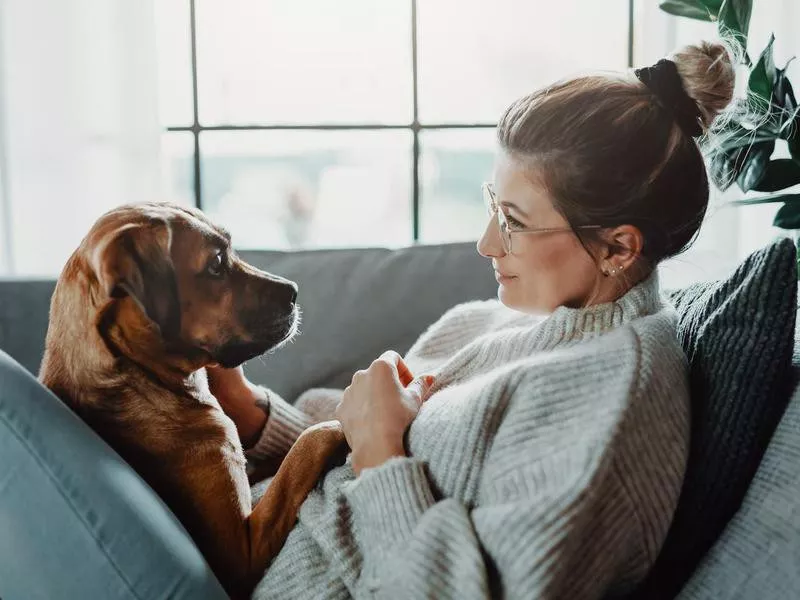
Getty Images
Dogs are very sensitive, and if they sense that you’re worried or anxious, they’ll take on those emotions, too. Act normally and don’t make a fuss. The more agitated you are, or if you’re behaving strangely, the more distressed your dog will be. Take some deep breaths, center yourself, and do whatever you do to relax.
Your dog can tell if you’re only going through the motions, so do your best to believe there’s nothing unusual going on and that there’s no cause for alarm. Your behavior may help relax your dog and assure them everything is going to be alright.
Seek Professional Help
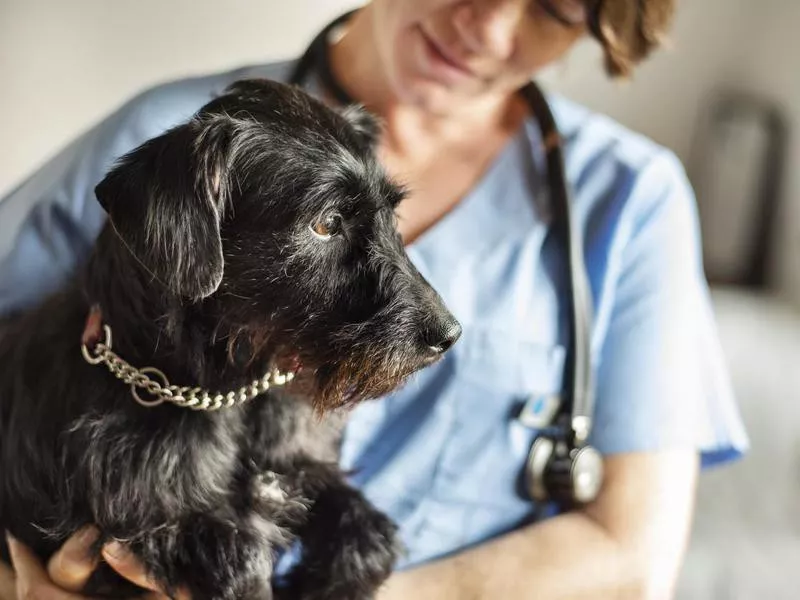
Getty Images
There are many kinds of herbal supplements, sprays and equipment that you can get to help your dog with their anxiety, but first, have your dog checked out by your vet. Your vet may be able to prescribe some medication such as sedatives to help your dog cope. You’ll want to know the optimal time to administer the medication, possible side effects and dosage.
Use a Spray
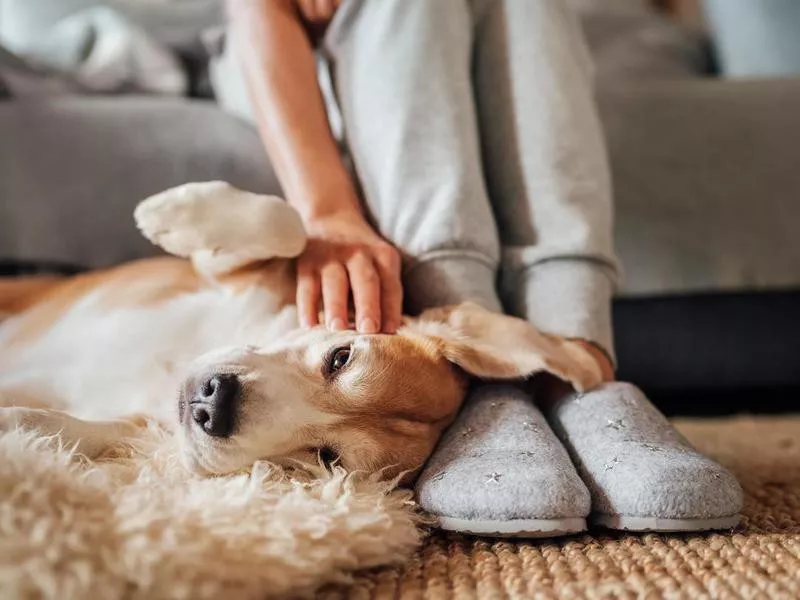
Getty Images
There are natural herbal calming sprays that can help in stressful situations. Many sprays are easily administered by sprinkling a few drops into your pet’s bedding or around them. Pheromones are also used to help a dog with anxiety and come in spray form, diffusers or are incorporated into a collar.
Wrap Your Dog Up
You can purchase or make a Thundershirt for your pup. Thundershirts look more like a harness or a vest than a shirt. When worn, a Thundershirt puts gentle pressure on your dog and helps to reduce its stress.
Using pressure is therapeutic and stress-relieving for animals and humans alike and an easy way to keep your dog calm by applying pressure.
Get Crafty
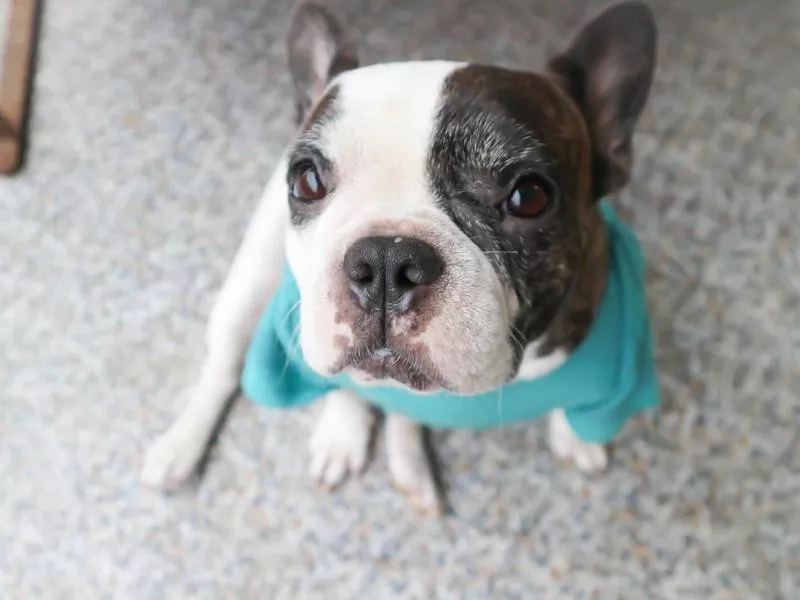
Getty Images
You can also make an anti-anxiety wrap out of an ace bandage or non-adhesive body wrap. Be careful to make sure as you surround your dog’s body with the bandage that it’s snug but not too tight. Think of it as if you were lightly swaddling an infant. You want a constant moderate pressure that physically assures your dog that they’re safe.
If you’re in a pinch, you can always use an extra-small T-shirt as a wrap for your dog. Don’t forget to put the T-shirt on backward, so your dog’s tail isn’t covered up by fabric.
Consider Getting a Calming Cap
Like with a Thundershirt, a calming cap is used to quiet and calm nervous and jittery dogs. While some people liken it to a blindfold, it’s more of a hood or soft fabric mask. The see-through fabric window reduces visual stimuli while still allowing your dog to maneuver its surroundings and play with its toys.
It’s important to note that it’s a good idea to introduce the cap to your dog before it is used to help with their anxiety. Don’t use it when your dog is alone — you don’t want to limit their senses when they might need them the most.
Distract Your Dog
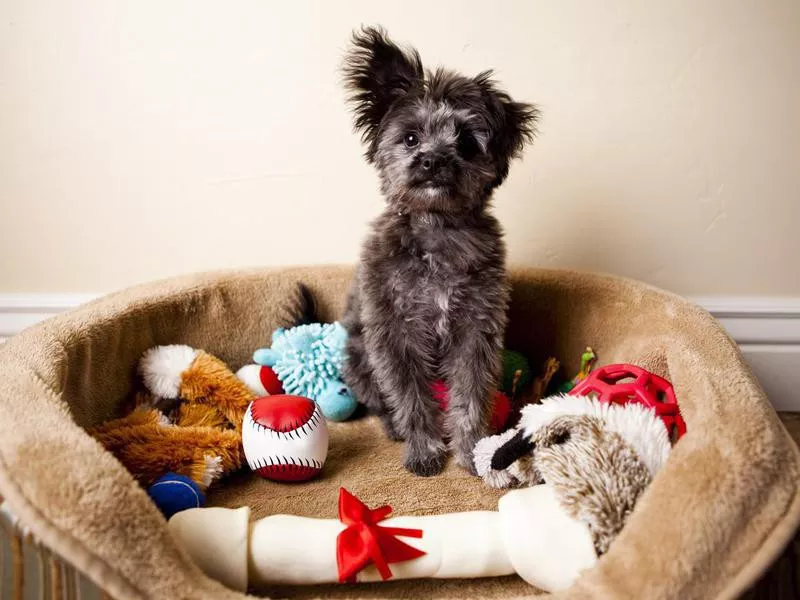
Getty Images
If your dog is having so much fun, they may forget they’re scared in the first place. Put your dog’s favorite toys out where they can see them. What are some of your dog’s favorite activities? Does he enjoy playing fetch, getting his fur brushed or playing tug of war? If so, go with the things he loves to do best.
If his regular activities and toys aren’t distracting enough, go for something mentally stimulating, such as teaching them new tricks or puzzle games. Does your dog enjoy digging? Then, get some old blankets that won’t disintegrate if they get pawed. Hide some toys or treats inside, and let your dog go treasure hunting among the blankets. Another fun thing to do is get an inexpensive but sturdy kiddie pool, fill it with balls and encourage your dog to jump in.
Block Out Some Sound
There’s no contest between dogs and humans regarding who has more sensitive hearing — dogs win it paws down. They can hear higher frequencies, pinpoint exact locations and hear sounds from farther away than humans. So, if your dog has trouble with loud thunderclaps or the boom of fireworks, Mutt Muffs could help keep your dog calm.
Mutt Muffs were created specifically to fit the shape of a dog’s head to give them the best passive sound reduction possible. Think of Mutt Muffs as noise-canceling headphones for dogs. Though they won’t block all the sound, they’ll mute it enough to help keep your pup feeling peaceful.
Give Your Dog a Chewy

Getty Images
Provide your dog with their favorite long-lasting chew treat, and your dog will be occupied and content for hours. The bonus is that many of these chews are good not only for your dog’s mood, but they also help keep their teeth clean and their gums healthy. In addition, some chews are made to be calming and contain organic herbs that are known to aid sleep, help digestion, lessen stress and ease anxiety.
If you plan to give your dog a calming treat, do so an hour or two before the stressful event is scheduled to begin. It’s much easier to keep a relaxed dog calm than to steady an anxious one.
Don’t Yell or Punish Them
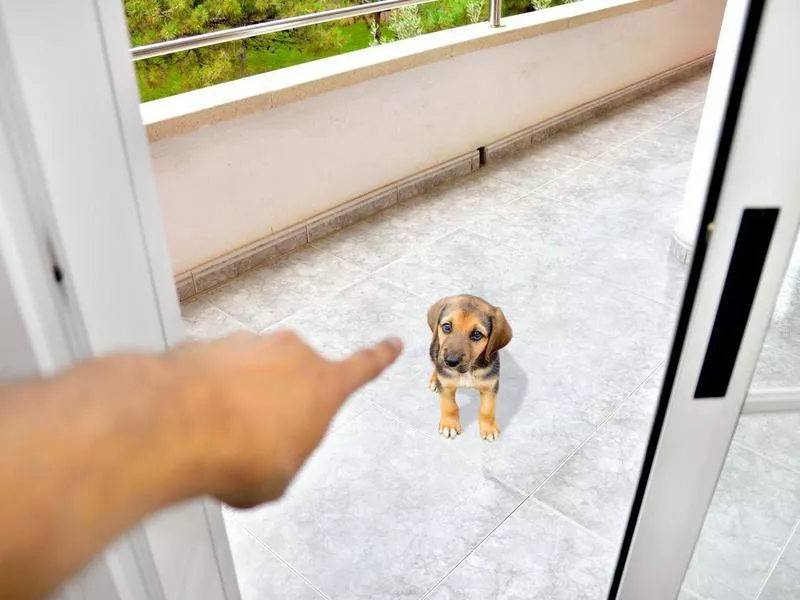
Getty Images
Seeing your dog acting out, whimpering or hearing them barking can affect your mood as well as theirs. You may lash out at your dog without meaning to and cause them even more distress. Shouting at them or any other kind of negative reinforcement won’t make the situation any better and make it much worse. Punishing them will prove to your dog that there’s something wrong going on.
Instead, try to stay calm, and if you can’t do that, act like you’re relaxed and happy. Your well-being is of vital importance to your dog, and if you can’t handle a storm or fireworks, it will only make your dog more stressed out.
Instigate Playtime

Getty Images
If your dog is focused on their fear, they may forget about the things they enjoy about life. Your dog needs you to demonstrate that they’re safe and it’s OK to have fun.
For example, play with one of their toys within range of their eyesight or hide some treats around the house and encourage a treat hunt.
Leave Them Alone

Credit: freepik
If your dog has indicated that they’d like to be left alone, honor their request, and leave them be. Check on them from time to time to make sure they’re OK, but don’t try to forcibly remove them from their hiding spot or aggressively try to tempt them out with food or treats.
When they feel safe and ready, they’ll come out on their own. Respect their need to self-soothe.
Make a Playdate
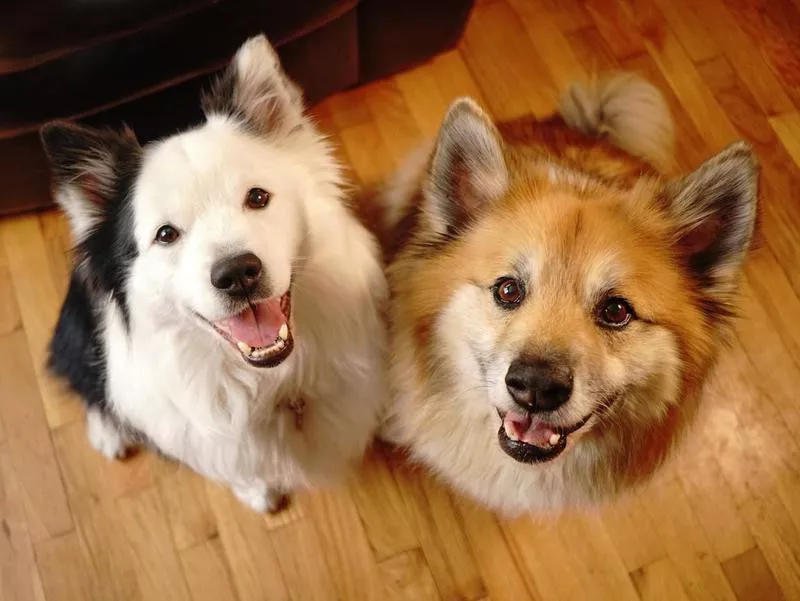
Getty Images
Not every dog has issues with loud noises or flashing lights. If your dog has a canine pal whom they adore and one who’s relaxed when it comes to thunderstorms or celebrations involving fireworks, set up a playdate.
When your dog sees that the other dog doesn’t react to the sights and sounds that alarm them, they may realize they don’t need to be scared either. If the dogs are having such a good time, your dog may not even notice what’s happening outside.
Desensitize Your Dog

Getty Images
Desensitizing and counterconditioning your dog is something that must be done in advance. For example, if your dog is sensitive to thunder, then play a recording of thunder, or if it’s the loud whistling, booming and cracking of fireworks that scares them, thenplay a fireworks display on your computer.
Keep the volume low for 10 minutes, then offer your dog a treat as counterconditioning. Your dog will begin to associate positive feelings with the source of their fearfulness and anxiety. Over time, increase the volume, but remember to pair the sounds with a reward. Desensitizing your dog isn’t a quick fix and may take weeks to take effect, but it could be well worth the time and energy spent.
Give Them a Rub Down
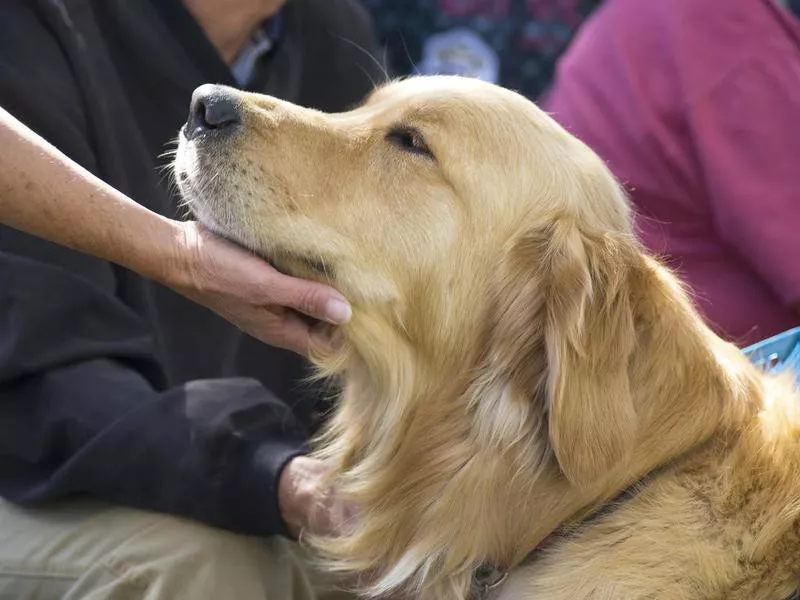
Getty Images
For some dogs, it’s not the sound of thunder that upsets them but the static electricity. Reduce the chances that your dog will get shocked by putting them in a grounded area such as a bathtub or basement.
One unusual tip to get your dog to calm down during a storm is to rub them all over with an anti-static dryer sheet. The sheet should be unscented and thrown away once you’re done, as they’re very toxic to dogs when ingested, but it will get rid of that static cling.
Massage Your Dog
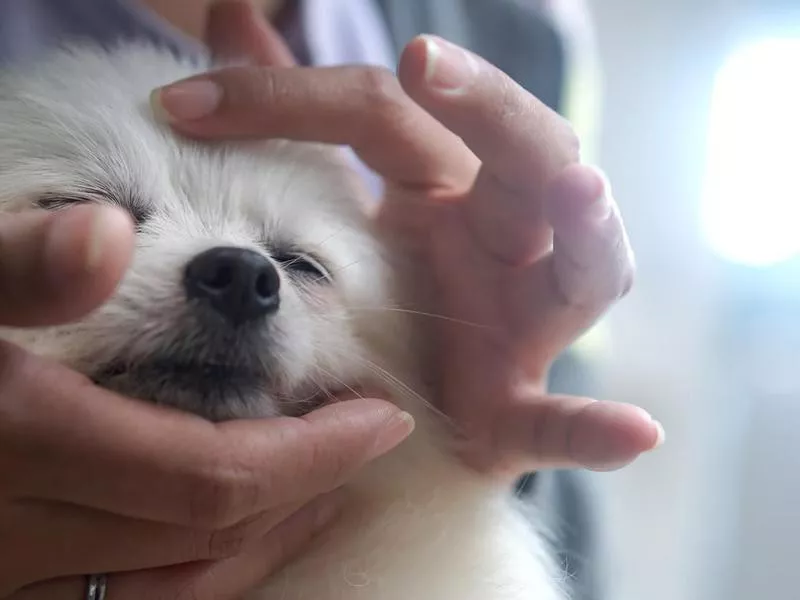
Getty Images
You don’t want to massage your dog when they’re experiencing a high level of anxiety and fear, but if they’re mostly OK, a massage could help. It’s up to your discretion whether a massage is appropriate or not.
If you decide to give them some touch-therapy, start by petting your dog all over. Touch their cheeks and forehead, massage their neck by making circular motions, and then move to the chest and front legs. Cradle your dog so they can see your face and sense your tranquility. Tell your dog what you’re doing in a soft voice. Don’t love-bomb them or over-cuddle them as it could do the opposite of what you want and alarm your dog. Your energy should be laid-back and mellow.
Don’t Forget About Them
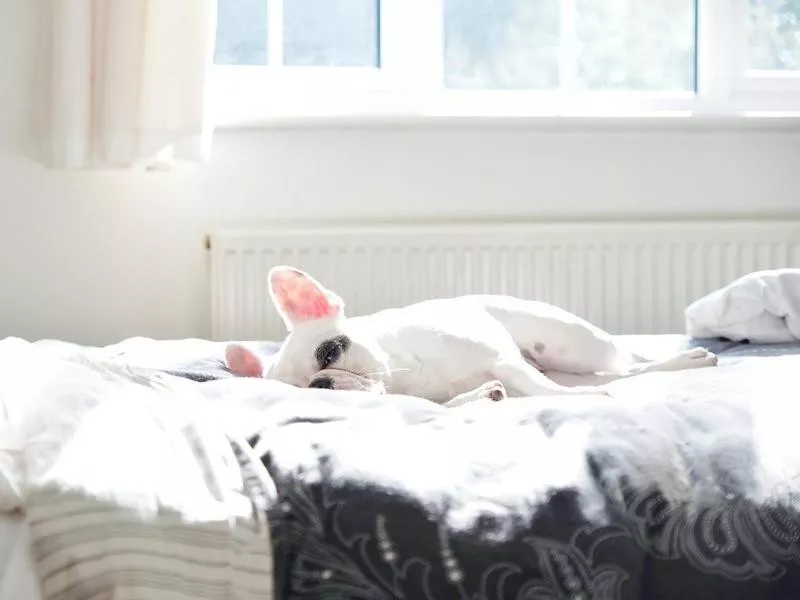
Getty Images
If your dog copes with its anxiety and fear by self-isolating, that’s OK. Let them do their thing. However, you need to look in on them from time to time and do a modified wellness check.
Do it as unobtrusively as possible. You don’t want to upset them all over again if they’ve started to relax a little. You’re just letting them know you’re there for them and making sure they’re not demonstrating any worrying symptoms.
Use CBD Oil

Getty Images
Some dog owners have had great success calming their pets with CBD oil. This is something you should talk to a vet about before administering. You don’t want to endanger your dog by giving them too much. There are many different kinds and applications of CBD, and your vet can advise which is best for your dog.
You’ll also want to know how much you should give them, any potential side effects and if there are any risks. CBD activates serotonin, which in turn interacts with the nervous system. This interaction can help to soothe your dog and help to alleviate their stress.
Hire a Professional
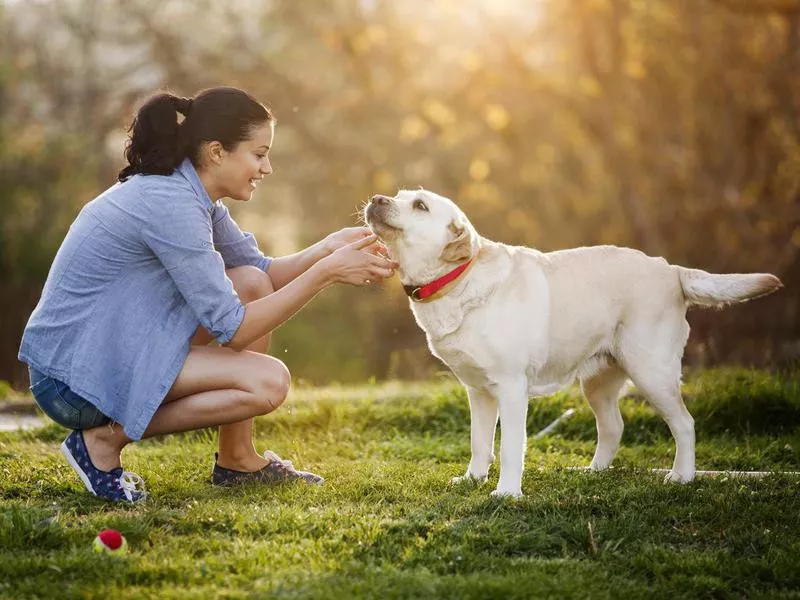
Getty Images
If your dog’s fear is intense and affects its quality of life, you may want to hire a professional. You want someone who’s been trained in animal behavior, behavior modification and someone who can teach you the best method of working with your dog. For example, a professional behaviorist can help train your dog so that loud noises don’t cause them to feel extreme amounts of anxiety, fear and stress.
A behavior management plan can take up to six months for your dog to complete and can be expensive. However, having a dog that doesn’t lose control when confronted with thunderstorms and fireworks is a gift.
Try Aromatherapy

Credit: iStockphoto
Some dogs respond surprisingly well to calming scents. Diffusing lavender or chamomile (both known for their relaxing effects) in the room where your dog likes to hang out can help create a peaceful atmosphere. Always use pet-safe essential oils in moderation and keep diffusers out of reach. You want a gentle, soothing vibe – not an overwhelming spa takeover.